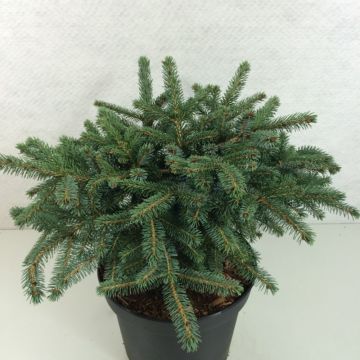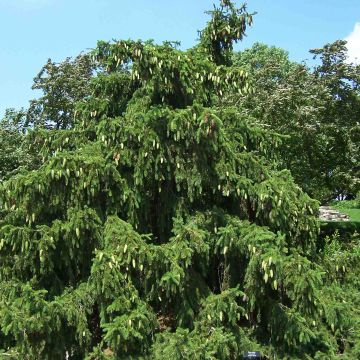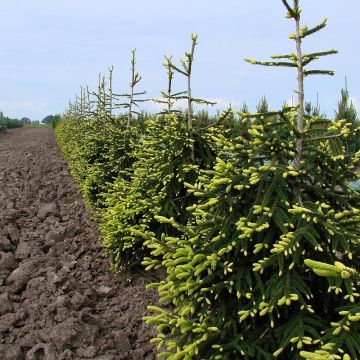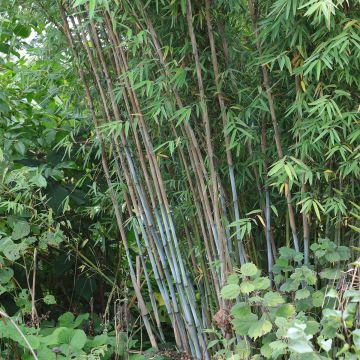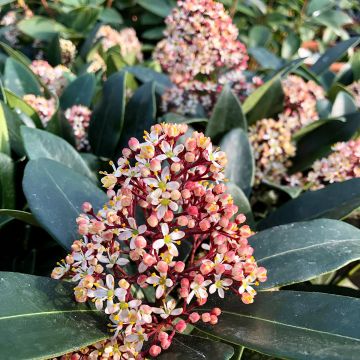

Picea orientalis Barnes - Sapinette d'Orient
Picea orientalis Barnes - Caucasian Spruce
Picea orientalis Barnes
Caucasian Spruce, Oriental Spruce
This item cannot be shipped to the selected country
Delivery charge from €5.90
More information
Schedule delivery date,
and select date in basket
This plant carries a 24 months recovery warranty
More information
We guarantee the quality of our plants for a full growing cycle, and will replace at our expense any plant that fails to recover under normal climatic and planting conditions.
From €5.90 for pickup delivery and €6.90 for home delivery
Express home delivery from €8.90.
Does this plant fit my garden?
Set up your Plantfit profile →
Description
Forming a lovely small round and spreading bush, with dense dark green foliage, Picea orientalis 'Barnes' is a dwarf variety of Oriental spruce. It shows a very slow growth, which slows down even more over the years. Its short and very dense branches resemble small slightly erect brushes, with a pretty light green colour in spring that darkens as the seasons progress. Its round and compact silhouette integrates well in small gardens, enlivens large rockeries, and works wonders in pots on the terrace. It is a vigorous and very hardy small conifer, low-maintenance and undemanding. It thrives in any well-drained but not too dry soil, and prefers a sunny exposure.
Picea orientalis, also known as Oriental spruce, is an evergreen conifer from the pine family, native to northeastern Turkey and the Caucasus. In its natural habitat, this large pyramidal tree reaching 30 metres (98 feet) in height grows both in humus-rich soil of mixed or evergreen forests, and on rocky slopes and cliffs along the Black Sea coast.
'Barnes' is an old cultivar that has made its way into parks and gardens on its own, and has only recently been officially recognized and registered. It stands out with its round and spreading habit that evokes a bird's nest, and its dark green and shiny foliage. Its growth is slow in the first years, around 7.5 to 10cm (3 to 4in) per year, and then it slows down even more, so that a 20-year-old specimen will not exceed 1.30m (4ft) in height and 2.40m (8ft) in diameter. It produces flexible and slightly trailing branches, quite short and very tight. They are covered with very short needles, diamond-shaped in section, shiny, radially arranged and very densely packed around the branches. They are shiny dark green on top and have 2 very discreet white bands underneath. The chamois-coloured buds release bright light green young shoots in spring that brighten up the old foliage.
The Oriental spruce 'Barnes' is a reliable choice and will find its place in all gardens, even the smallest ones. With its easy cultivation, its presence and very limited development, it is a perfect plant for small spaces, large rockeries, and terraces. It thrives in many situations and adapts to various climates, as long as the soil is well-drained. It can be adopted without reservation in a large embankment, among rocks, above a wall or ledge, or near a swimming pool, as it blends well with geometric lines and masonry structures. The graphic qualities of conifers naturally impose themselves in the design of a contemporary garden, which prefers the aesthetics of shapes, silhouettes, and textures over the dance of blooms. These plants with their reassuring permanence provide lasting structure to a flower bed, mark pathways, border the terrace, easily replacing the strong presence of trimmed boxwood or holly. They pair well with heathers, shrubby salvias, or ground-cover plants such as aubrietas and Cerastes, as well as with light-flowering shrubs like Gauras. The key is to play with volumes and colours.
Report an error about the product description
Picea orientalis Barnes - Caucasian Spruce in pictures
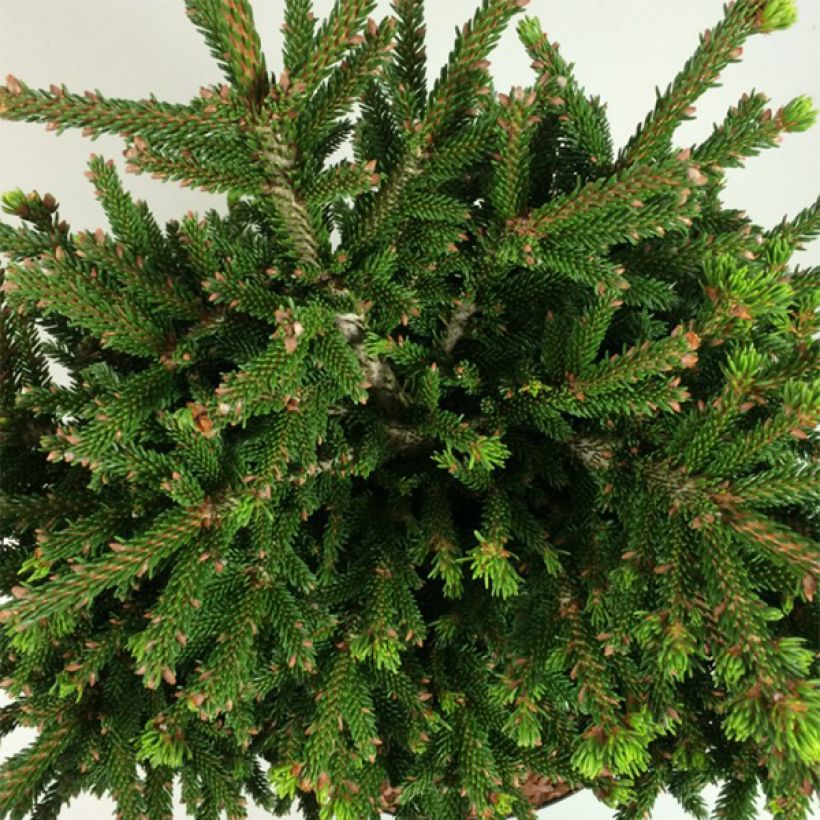



Plant habit
Foliage
Botanical data
Picea
orientalis
Barnes
Pinaceae
Caucasian Spruce, Oriental Spruce
Cultivar or hybrid
Other Picea
Planting and care
Picea orientalis 'Barnes' is planted from September to November and from February to June in ordinary, well-drained, moist or dry, rather fertile, even slightly limestone and occasionally dry soil. Sandy, humus-rich or rocky soil will be perfectly suitable. Choose a sunny location or, at most, partially shaded. This variety is resistant to wind. Soak the root balls well before planting. Apply organic amendment at planting and water generously in the first years, and in case of prolonged drought. Apply a special conifer fertilizer every year in April and cultivate the soil in summer. This very hardy conifer (up to -30°C (1°F) at least) is, however, sensitive to heavy, waterlogged soils in winter. Pruning is normally not necessary. Sometimes, an erect axial branch emerges from the bush, returning to the original growth habit of Picea orientalis. In this case, it will be necessary to remove it to maintain a regular habit.
Planting period
Intended location
Care
This item has not been reviewed yet - be the first to leave a review about it.
Evergreen shrubs
Haven't found what you were looking for?
Hardiness is the lowest winter temperature a plant can endure without suffering serious damage or even dying. However, hardiness is affected by location (a sheltered area, such as a patio), protection (winter cover) and soil type (hardiness is improved by well-drained soil).

Photo Sharing Terms & Conditions
In order to encourage gardeners to interact and share their experiences, Promesse de fleurs offers various media enabling content to be uploaded onto its Site - in particular via the ‘Photo sharing’ module.
The User agrees to refrain from:
- Posting any content that is illegal, prejudicial, insulting, racist, inciteful to hatred, revisionist, contrary to public decency, that infringes on privacy or on the privacy rights of third parties, in particular the publicity rights of persons and goods, intellectual property rights, or the right to privacy.
- Submitting content on behalf of a third party;
- Impersonate the identity of a third party and/or publish any personal information about a third party;
In general, the User undertakes to refrain from any unethical behaviour.
All Content (in particular text, comments, files, images, photos, videos, creative works, etc.), which may be subject to property or intellectual property rights, image or other private rights, shall remain the property of the User, subject to the limited rights granted by the terms of the licence granted by Promesse de fleurs as stated below. Users are at liberty to publish or not to publish such Content on the Site, notably via the ‘Photo Sharing’ facility, and accept that this Content shall be made public and freely accessible, notably on the Internet.
Users further acknowledge, undertake to have ,and guarantee that they hold all necessary rights and permissions to publish such material on the Site, in particular with regard to the legislation in force pertaining to any privacy, property, intellectual property, image, or contractual rights, or rights of any other nature. By publishing such Content on the Site, Users acknowledge accepting full liability as publishers of the Content within the meaning of the law, and grant Promesse de fleurs, free of charge, an inclusive, worldwide licence for the said Content for the entire duration of its publication, including all reproduction, representation, up/downloading, displaying, performing, transmission, and storage rights.
Users also grant permission for their name to be linked to the Content and accept that this link may not always be made available.
By engaging in posting material, Users consent to their Content becoming automatically accessible on the Internet, in particular on other sites and/or blogs and/or web pages of the Promesse de fleurs site, including in particular social pages and the Promesse de fleurs catalogue.
Users may secure the removal of entrusted content free of charge by issuing a simple request via our contact form.
The flowering period indicated on our website applies to countries and regions located in USDA zone 8 (France, the United Kingdom, Ireland, the Netherlands, etc.)
It will vary according to where you live:
- In zones 9 to 10 (Italy, Spain, Greece, etc.), flowering will occur about 2 to 4 weeks earlier.
- In zones 6 to 7 (Germany, Poland, Slovenia, and lower mountainous regions), flowering will be delayed by 2 to 3 weeks.
- In zone 5 (Central Europe, Scandinavia), blooming will be delayed by 3 to 5 weeks.
In temperate climates, pruning of spring-flowering shrubs (forsythia, spireas, etc.) should be done just after flowering.
Pruning of summer-flowering shrubs (Indian Lilac, Perovskia, etc.) can be done in winter or spring.
In cold regions as well as with frost-sensitive plants, avoid pruning too early when severe frosts may still occur.
The planting period indicated on our website applies to countries and regions located in USDA zone 8 (France, United Kingdom, Ireland, Netherlands).
It will vary according to where you live:
- In Mediterranean zones (Marseille, Madrid, Milan, etc.), autumn and winter are the best planting periods.
- In continental zones (Strasbourg, Munich, Vienna, etc.), delay planting by 2 to 3 weeks in spring and bring it forward by 2 to 4 weeks in autumn.
- In mountainous regions (the Alps, Pyrenees, Carpathians, etc.), it is best to plant in late spring (May-June) or late summer (August-September).
The harvesting period indicated on our website applies to countries and regions in USDA zone 8 (France, England, Ireland, the Netherlands).
In colder areas (Scandinavia, Poland, Austria...) fruit and vegetable harvests are likely to be delayed by 3-4 weeks.
In warmer areas (Italy, Spain, Greece, etc.), harvesting will probably take place earlier, depending on weather conditions.
The sowing periods indicated on our website apply to countries and regions within USDA Zone 8 (France, UK, Ireland, Netherlands).
In colder areas (Scandinavia, Poland, Austria...), delay any outdoor sowing by 3-4 weeks, or sow under glass.
In warmer climes (Italy, Spain, Greece, etc.), bring outdoor sowing forward by a few weeks.






































